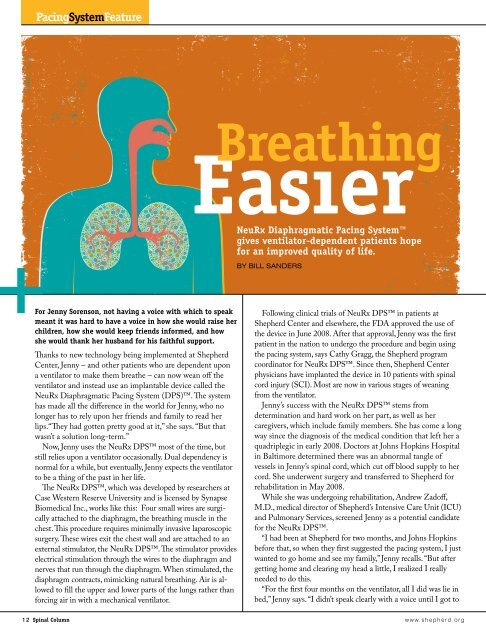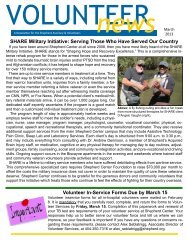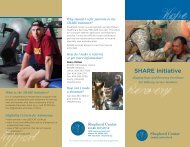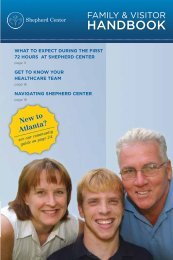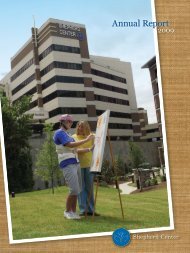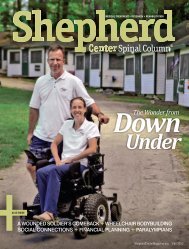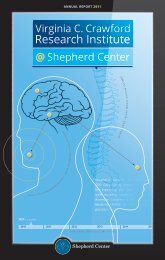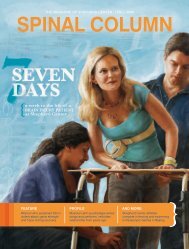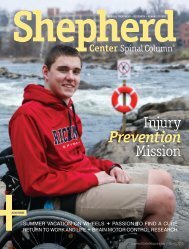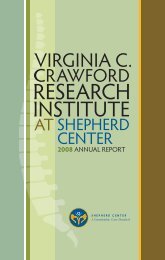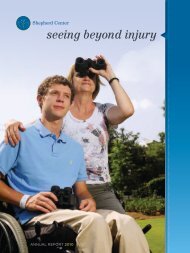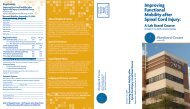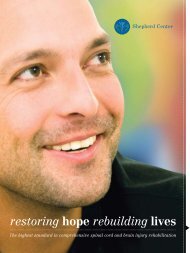the BRAIN - Shepherd Center
the BRAIN - Shepherd Center
the BRAIN - Shepherd Center
You also want an ePaper? Increase the reach of your titles
YUMPU automatically turns print PDFs into web optimized ePapers that Google loves.
PacingSystemFeature<br />
Breathing<br />
NeuRx Diaphragmatic Pacing System<br />
gives ventilator-dependent patients hope<br />
for an improved quality of life.<br />
By Bill Sanders<br />
For Jenny Sorenson, not having a voice with which to speak<br />
meant it was hard to have a voice in how she would raise her<br />
children, how she would keep friends informed, and how<br />
she would thank her husband for his faithful support.<br />
Thanks to new technology being implemented at <strong>Shepherd</strong><br />
<strong>Center</strong>, Jenny – and o<strong>the</strong>r patients who are dependent upon<br />
a ventilator to make <strong>the</strong>m brea<strong>the</strong> – can now wean off <strong>the</strong><br />
ventilator and instead use an implantable device called <strong>the</strong><br />
NeuRx Diaphragmatic Pacing System (DPS). The system<br />
has made all <strong>the</strong> difference in <strong>the</strong> world for Jenny, who no<br />
longer has to rely upon her friends and family to read her<br />
lips.“They had gotten pretty good at it,” she says. “But that<br />
wasn’t a solution long-term.”<br />
Now, Jenny uses <strong>the</strong> NeuRx DPS most of <strong>the</strong> time, but<br />
still relies upon a ventilator occasionally. Dual dependency is<br />
normal for a while, but eventually, Jenny expects <strong>the</strong> ventilator<br />
to be a thing of <strong>the</strong> past in her life.<br />
The NeuRx DPS, which was developed by researchers at<br />
Case Western Reserve University and is licensed by Synapse<br />
Biomedical Inc., works like this: Four small wires are surgically<br />
attached to <strong>the</strong> diaphragm, <strong>the</strong> breathing muscle in <strong>the</strong><br />
chest. This procedure requires minimally invasive laparoscopic<br />
surgery. These wires exit <strong>the</strong> chest wall and are attached to an<br />
external stimulator, <strong>the</strong> NeuRx DPS. The stimulator provides<br />
electrical stimulation through <strong>the</strong> wires to <strong>the</strong> diaphragm and<br />
nerves that run through <strong>the</strong> diaphragm. When stimulated, <strong>the</strong><br />
diaphragm contracts, mimicking natural breathing. Air is allowed<br />
to fill <strong>the</strong> upper and lower parts of <strong>the</strong> lungs ra<strong>the</strong>r than<br />
forcing air in with a mechanical ventilator.<br />
Following clinical trials of NeuRx DPS in patients at<br />
<strong>Shepherd</strong> <strong>Center</strong> and elsewhere, <strong>the</strong> FDA approved <strong>the</strong> use of<br />
<strong>the</strong> device in June 2008. After that approval, Jenny was <strong>the</strong> first<br />
patient in <strong>the</strong> nation to undergo <strong>the</strong> procedure and begin using<br />
<strong>the</strong> pacing system, says Cathy Gragg, <strong>the</strong> <strong>Shepherd</strong> program<br />
coordinator for NeuRx DPS. Since <strong>the</strong>n, <strong>Shepherd</strong> <strong>Center</strong><br />
physicians have implanted <strong>the</strong> device in 10 patients with spinal<br />
cord injury (SCI). Most are now in various stages of weaning<br />
from <strong>the</strong> ventilator.<br />
Jenny’s success with <strong>the</strong> NeuRx DPS stems from<br />
determination and hard work on her part, as well as her<br />
caregivers, which include family members. She has come a long<br />
way since <strong>the</strong> diagnosis of <strong>the</strong> medical condition that left her a<br />
quadriplegic in early 2008. Doctors at Johns Hopkins Hospital<br />
in Baltimore determined <strong>the</strong>re was an abnormal tangle of<br />
vessels in Jenny’s spinal cord, which cut off blood supply to her<br />
cord. She underwent surgery and transferred to <strong>Shepherd</strong> for<br />
rehabilitation in May 2008.<br />
While she was undergoing rehabilitation, Andrew Zadoff,<br />
M.D., medical director of <strong>Shepherd</strong>’s Intensive Care Unit (ICU)<br />
and Pulmonary Services, screened Jenny as a potential candidate<br />
for <strong>the</strong> NeuRx DPS.<br />
“I had been at <strong>Shepherd</strong> for two months, and Johns Hopkins<br />
before that, so when <strong>the</strong>y first suggested <strong>the</strong> pacing system, I just<br />
wanted to go home and see my family,” Jenny recalls. “But after<br />
getting home and clearing my head a little, I realized I really<br />
needed to do this.<br />
“For <strong>the</strong> first four months on <strong>the</strong> ventilator, all I did was lie in<br />
bed,” Jenny says. “I didn’t speak clearly with a voice until I got to<br />
1 2 Spinal Column<br />
w w w. s h e p h e r d . o r g


